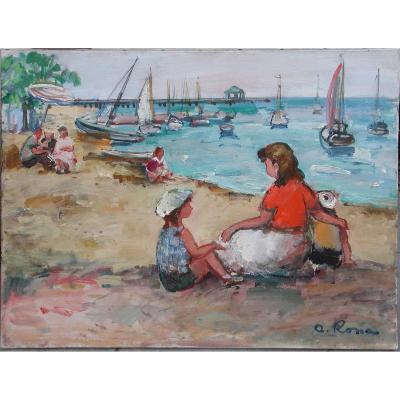Four Eyes
(4) Oil on canvas, cm 26 x 18
With frame, cm 40 x 32
The seventeenth century is a century characterized by several factors of crisis: the famines of the first decades, the disastrous Thirty Years' War, the recurrent plagues, including that which affected the entire continent between 1661 and 1668, the resulting demographic collapse. As a result, scenes of poverty are a common subject at that time in history. Since poverty was a dramatically evident aspect of the daily and the object of a new religious sensitivity, "gender painting" which in Italy, as well as north of the Alps, was established during the 17th century, It is particularly aimed at the representation of the poor, the so-called "pitocchi" (from the Greek ptokós, "mendico", "indigente"). The pitocco is the poor beggar, who lives on the edge of the social fabric: the art that portrays him marks a detachment from traditional religious and mythological subjects and expresses an innovative and unprecedented attention to the social reality of the time, often accompanied by a pitiful look and, in cases like this, a good dose of satire and irony. The representation of poverty and indigence, before spreading in the artistic field, interested literature: we need only think of the picaresque novel El Lazarillo de Tormes - anonymous Spanish text published in Burgos in 1554, story of the terrible apprenticeship of a street boy at a greedy and violent pitocco - or to the Ingenioso hidalgo don Quijote de la Mancha by Cervantes published in two times, between 1605 and 1615, with the well-known events of a decadute Spanish nobleman, Reduced to a hallucinated wandering, in search of a lost world, that of chivalry.The extraordinary birth and diffusion of the Commedia dell'arte, with its caricatural and excessive characters that stage vices, virtues and attitudes of the members of the lower strata of society, certainly contributed to this phenomenon. Literature gave this subject a new nobility of representation, which thus catalyzed the interest of the artists of the time. Between the evidences of daily reality and literary elaborations, Italian painters approached the icons of the pitocchi as to characters worthy of representation. Their action developed in the direction of genre painting, in comparison with the Flemings, and in the pictorial exploration of poverty accomplished by Jusepe de Ribera, who probably stayed not only in Naples but also in Emilia and Lombardy in 1611. Meanwhile, from France came first the suggestions of Callot - determinants were his picaresque engravings, in the context of the spread of the genre - and later those resulting from the works of the brothers Le Nain. In the field of genre painting, we can identify two different expressive strands: the first, within which are channeled the works of a large contingent of artists active between Veneto and Lombardy, which is connected to the literature of the time and that presents itself as a free interpretation of the furry actions of the poor and the vagabonds, characterized by a certain grotesque deformation - think, in the Lombardy area, to the action carried out by Giacomo Francesco Cipper called the Todeschini (Feldkirch, Austria 1664 - Milan 1736) and by Bergamasco Antonio Cifrondi (1656-1730); the second strand, with which the concept of painting reality is ripened, is excellently represented by the works of the Milanese Giacomo Ceruti, known as the Pitocchetto, who worked for a long time between Brescia and the Veneto region: He read the stories of the poor in a narrative that took into account new charitable instances, giving subjects a deep dignity, as shown, among others, by the extraordinary paintings currently held at the Pinacoteca Tosio Martinengo in Brescia.
Belonging certainly to the most grotesque and burlesque vein of the representation of the pitocchi are these four small canvases ascribable to the brush of the Venetian Matteo Ghidoni, better known as Matteo dei Pitocchi. Probably born in Florence (as Mina Gregori recalls in 1961, there is no literary source that allows us to reconstruct his biography) but mainly active in Padua, the artist looks at models provided by Callot’s prints or the genre scenes of the Flemish people operating around the middle of the 17th century in Italy. The works of the artist are characterized by intense colors and terrei for a quick and cursive technique. The colour register is poor and bituminous, and the material is dense. The four paintings in question, due to the similarities with some of the youthful pieces of the artist’s production, with particular reference to the Mendicante che si scalda le mani della Pinacoteca Querini Stampalia di Venezia (at the same institution, the same artist is also preserved The peasant revolt, painted to fully show the ability of the Ghidoni to manage even choral scenes), could be dated between the late 40’s and 50’s of '600. In the seventeenth and eighteenth-century inventories of private Venetian collections, as Francesco Frangi recalls (in From Caravaggio to Ceruti. The genre scene and the imaginary of the Pitocchi in Italian painting, 1998), it is in fact often referred to the presence of several paintings by Ghidoni depicting individual figures of pitocchi, whose iconography are found to be attributable to models of Bellotti and Monsù Bernardo; In particular, Monsù Bernardo, a Danish student of Rembrandt who worked mainly between Venice and Bergamo, is a fundamental reference point for the artist’s work.
Of particular interest are also the frames of the paintings, certainly coeve and with great artistic value. These have a box shape and a band decorated with flowers and abstract relief motifs. These were painted in the Veneto region in the first half of the 17th century (F. Sabatelli, La cornice italiana dal Rinascimento al Neoclassico, 1992, pp. 194-195): this seems to be absolutely consistent with the attribution of the paintings to Matteo Ghidoni, who was almost exclusively active in Veneto.


















































 Le Magazine de PROANTIC
Le Magazine de PROANTIC TRÉSORS Magazine
TRÉSORS Magazine Rivista Artiquariato
Rivista Artiquariato